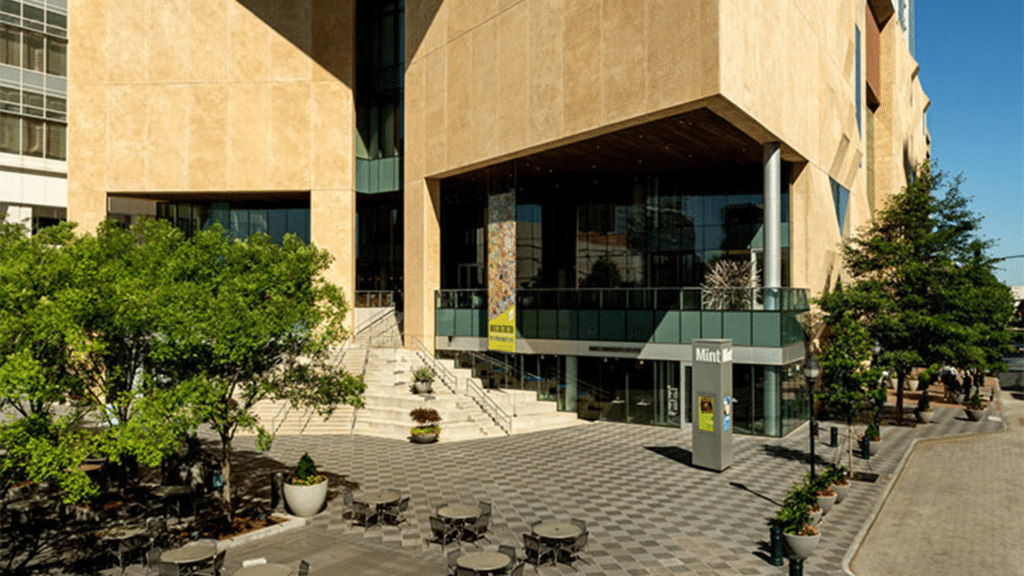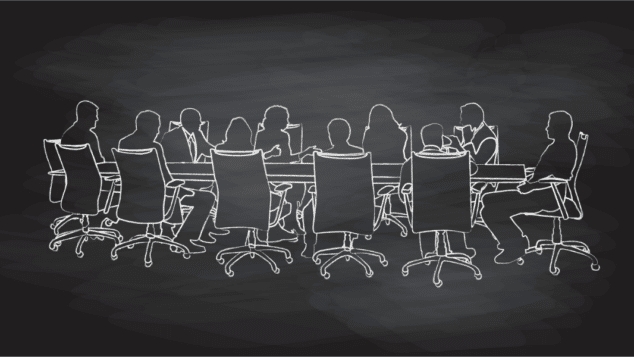Registrar Extraordinaire

 Michele Leopold, Director of Collections & Exhibitions, Mint Museum
Michele Leopold, Director of Collections & Exhibitions, Mint Museum
Michele Leopold is the director of collections & exhibitions at Mint Museum and treasurer for the Association of Registrars and Collection Specialists (ARCS). She has over thirty years of experience in collections, risk management, fine art insurance and project management for cultural institutions. Previous positions: Registrar & Collections Manager, NASCAR Hall of Fame Vice President, Huntington T. Block Insurance/AON Registrar, The John and Mable Ringling Museum of Art Collections Manager/Chief Registrar, The Atlanta History Center Chief Registrar, United States Holocaust Memorial Museum
Raise your hand if you are doing the exact job you thought you’d be doing when you graduated college. As many in the association industry can attest, career paths tend to be winding roads that can take you on a fascinating journey into industries and positions you never knew existed. Michele Leopold, director of collections & Exhibitions at Mint Museum in Charlotte, NC, shared with the how she found herself in the wonderful world of museums.
FORUM: You’ve held positions in both nonprofit and corporate organizations. How did you get into this line of work? What about your background made this a perfect fit?
Leopold: I studied math and German studies in college. I was never formally trained for this line of work. In fact, I had no idea that this line of work even existed!
Fortunately, after college a family friend was working in a placement office in Washington, D.C. and her firm was looking for an entry-level person who was bilingual in German & English. I applied for the job and found myself hired as one of the inaugural staff for a new museum being built in Washington, D.C. Using my language skills was critical for the planning and construction phase of the United States Holocaust Memorial Museum. A colleague who had been hired from the Smithsonian Sackler Museum saw my potential and took the initiative to train me as a registrar. This line of work came naturally to me—passion for the artifacts, passion for the organizational aspects of collecting, the organizing, archiving, tracking, conservation and logistics, the interaction with the donors and lenders. It was such an exciting time! Working in DC, I could connect with other colleagues in the museum field and continued my career path there for 12 years.
Mid-career, when I crossed over to the corporate sector, I took a position as an insurance broker with a firm that catered to clients with fine art—museums, galleries, dealers, artists and private collectors. It was a natural progression as I had already been working in the field for so long and could speak their language and understand their needs. The math background was beneficial as I built policies catered to their insurance needs.
FORUM: What is the best educational background for registrars?
Registrars come from all avenues of education and background. A second language is always helpful especially if you are working with fine art. Project management and strong organizational skills are beneficial to keep all the various projects, exhibitions and daily maintenance of the collection moving smoothly. Interpersonal skills are key as the Registrar interacts with many other internal and external stakeholders: vendors, donors, lenders, museum colleagues. There are many museum studies programs around the United States that offer an MA in Museum Studies and Registrars come out of those programs. But in looking back at my career, it is my opinion that there are others who have the skillset necessary to become a registrar and I often include those people when I am interviewing for any open positions.
FORUM: What is a normal day like for you?
As the director of collections & exhibitions here at the Mint Museum, I am no longer involved with the day to day hands on management of the collection, rather the management of the staff who support that function. My team of 12 is comprised of three areas: Registration, Art Installation & Fine Art Services and Exhibition Design.
I work primarily with my Coordinator of Exhibitions to create, disseminate and manage all Exhibition activities. I set the master exhibition calendar and manage all of the exhibition budgets and departmental budgets for my division.
I meet weekly with my fellow senior staff members and our museum director. I review and write exhibition contracts, negotiate traveling exhibition rates, promote our traveling exhibition program, and manage the department heads on my team. I spend time daily meeting with internal colleagues; often the exhibition projects involve the curators, the educators, the marketing specialist and the development staff. We strive to set our exhibition program 3-4 years out from the opening date and coordinating staff to complete these projects within a specific timeframe requires a bit of “people wrangling”. Every day is a new day and it is nice to have a job that is so multi-faceted. There is no such thing as a “normal day” in a museum setting.
FORUM: What is the timeframe on rotation of certain objects? For example, do certain works on paper get to stay on exhibit for years or do they have to come down on a schedule? How do you keep track of all of the objects?
Every object has a standard light level requirement and display requirement based on the medium (materials) used to create the object. Paper is perhaps the most affected by light/display but there are also textile objects that are fragile and require more care. Our Chief Registrar tracks all objects in fine art storage, on loan or on display. We rotate paper every 6-8 months, textiles every year and other framed fine art 18-24 months. The registration team has a dedicated database geared to museum collections to track all of the data related to the objects in our care, custody and control. (our collections and loans to us).
Pests are also damaging to objects, so we employ an IPM—Integrated Pest Management—program. The registrars monitor all areas with objects by reviewing pest traps and identifying any insect activity. Being proactive allows us to further protect the collections collaborating with our facilities staff to address any issues before it becomes a problem.
FORUM: What have been your most challenging objects to move?
Holocaust-era railroad car: Had to move a railroad car from the interior of Poland to the port of Gdansk for travel by sea to the US. While transporting overland in Poland, the railroad car was shunted off on a side railroad track and for about 3 days we “lost” a railroad car! Fortunately, it was located and made it safely onto a cargo freighter headed to Baltimore, Maryland. Once in the States, we stored the railroad car until the construction site was ready to receive it. It was then transported overland on an oversized flatbed tractor trailer. We had a number of structural engineers and rigging companies involved and at the ready on the day we “installed” the railroad car. It was securely rigged and hoisted into the air and placed inside construction site that would become the museum. A waterproof and secure housing was constructed around the railroad car to further protect it during the final construction phases. Once the building shell was complete, the protective housing was removed. The railroad car is significant because it still has the original Nazi paint and markings from the 1940’s. It continues to be an important collection object on display at the US Holocaust Memorial Museum in Washington DC.
Panama Canal bucket: The Mint Museum created a traveling exhibition about the building of the Panama Canal. Our curator located one of the three remaining buckets that was used to dig the canal in Colorado. The three-ton bucket was transferred overland and then placed into our galleries here as part of the exhibition in Charlotte. We had to arrange for permits, work with the architects, coordinate all of the logistics with riggers and find an overland conveyance that would safely transport the bucket to Charlotte. It was a huge success!
Oversize framed artwork: Often museums lend large framed works of art to other institutions. When they travel internationally, they cannot go in a regular commercial air carrier and must be transported by cargo plane. Generally, the museum will require a courier to ride with the crated artwork to ensure its safety door to door. As was the case at the Ringling Museum of Art, I was asked to accompany a large work to Venice, Italy. The crate and I were trucked from Sarasota, Florida to Atlanta, Georgia where we connected with our cargo plane. Cargo planes do not have the amenities that a regular air carrier does. There are only the pilots, a few additional seats, one restroom and the courier. There may also be a veterinarian on the plane if there are horses in the hold. Upon landing in Milan, Italy, the crate and I traveled overland by climate-controlled truck to a terminal near Venice. The crate was then strapped and secured onto a motor boat in the canal and we traveled the final leg of this journey over water to the palace where it was then placed on view. While such a journey may seem glamorous to some people, it can be a nerve-wracking journey should anything go wrong. Door to door this trip took well over 24 hours. The courier needs to be vigilant and advocate for the safety of the art always.
FORUM: What do you see as the most challenging aspect of the career of registrars in the future?
As I am currently sitting in a professional association board meeting as I type this, I would have to say a great deal of conversation has surfaced around the table today about salary inequity. Registrars are required to draft and negotiate legal documents, manage staff, be experts in the field for fine art insurance, have working knowledge of conservation and conservation techniques to properly care for and protect the artwork, keep current with customs shipping regulations, oversee data entry to record all logistics and historic information and understand the scientific composition of archival materials used in the packing, shipping and storage of objects. In addition, most employers are looking for candidates with advanced degrees, a MA or higher and years of experience. Unfortunately, the salary offered is not commensurate with experience. As an advocate for our field we are looking for ways to provide educational programs or certificate programs to assist our members in lobbying for higher wages.
FORUM: Tell us about your participation in ARCS.
ARCS is a professional association that was formed in 2012 to support and promote the field of registration and collections management specialists. We currently have 1100 members from the United States, Canada, and Europe.
I joined the board of directors in 2014 as the chair for development and worked with a team of three colleagues to raise money to support our organization, educational programs and conferences. In 2016, I was nominated to take over as the Treasurer for the association. I currently sit on the Executive Board as the treasurer and I participate on the Development Committee. My 3-year volunteer term will expire in June 2020.
We are gearing up for our biannual conference to be held in Philadelphia in November 2019 and are very excited by the possibilities that this conference will bring. The buzz on the street is that this conference may be our biggest to date with approximately 850 participants.
Our last conference was held in Vancouver BC in 2017, where we were pleasantly surprised to see over 700 participants. The 2019 conference in Philadelphia is sure to capture a large number of museum professionals in the NE corridor as well as international registrants, so this year is shaping up to be a busy one!
Tags
Related Articles
Great Bosses, Greater Impact: Leadership Lessons that Stick
The best bosses leave more than instructions—they leave echoes of confidence, creativity, and leadership that...
4 Key Strengths of an Association’s Board
A 2023 study asked association leaders which strengths are vital to a board. Read what...
CEO Perspectives on Association Forum’s Governance Professional Practice Statments
Association Forum members have access to professional practice statements. A committee reviews these statements annually....




